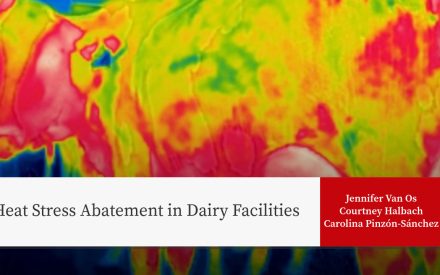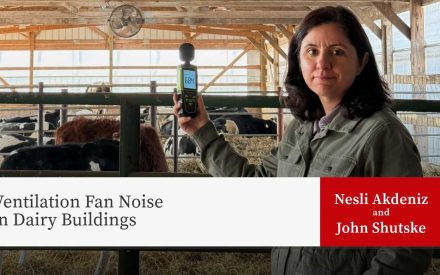Introduction
Most dairy managers dream of the “anonymous” cow. Trouble-free in udder conformation and mobility; rarely, if ever, treated for health events; and breeds back year after year. She’s anonymous because, on a day-to-day basis, our only interaction with her is milking. Anonymous cows do not need to be handled or receive special attention. Dr. Matt Lucy at the University of Missouri posits that these anonymous cows can better handle the daily stressors they encounter. Why do cows that face a common challenge (Stress) respond differently to it (Strain), and how do managers capitalize on this? The short answer is genetics, but it isn’t that simple, and we will discuss it in this article.
Stress: a force that results in a biological response
Strain: the animal’s response to that stress

When dealing with cattle, we must remember that they are a prey species and experience metabolic and behavioral changes in response to stress. Stressors can be broadly categorized as:
- Environmental
- Disease
- Production
- Nutritional
- Psychological
To demonstrate, we can look at an example of an environmental stressor: heat and humidity. The stressor (heat and humidity) is applied equally to all animals. The strain, however, is the individual animal’s response to the stressor. In this example, we can measure individual animal’s responses (strain) through elevated body temperature. This response can vary widely between animals, with different cows having different levels and rates of increased body temperature.
We can’t prevent all stressors from occurring. In this example, we can’t control the weather. However, not all the burden should be placed on the cow. Herd managers have an essential role in providing ventilation, shade, and other heat mitigation measures. Even if we select more resilient cows in our herd, that alone will not overcome deficiencies in our management (a resilient cow placed in a poor environment will still experience strain and production declines).
Reproduction Revolution
In what Dr. Paul Fricke coined the “Reproduction Revolution,” most dairy herds have adopted breeding protocols that fit their management system and improved their pregnancy rates. Double Ovsynch was a game changer for farms using synchronization. The adoption of activity monitoring technology has helped other herds improve pregnancy rates through improved service rates.
Since the “Reproduction Revolution,” we need to look for other ways to continue improving pregnancy rates without changing what’s already working for farms. Finding ways to continually improve has brought us back to the basics: optimizing the cow’s health and environment to find those few extra points in herd fertility. We can utilize the Stress and Strain framework to identify stressors that are detrimental to uterine and ovarian function. When looking for ways to continually improve, we need to remember that success is defined as a cow that:
- Resumes cyclicity postpartum
- Ovulates a fertile ovum
- Has a uterine environment that will accept an embryo and maintain pregnancy
Environmental, Health, and Disease
Dairy farmers are already focused on preventing and quickly diagnosing diseases due to their negative impacts on production. However, this is an opportunity to highlight health events that also impact reproduction.
Examples of some of the mechanisms by which health events impact fertility include:
- Fever resulting in increased body temperature
- Decreased feed intake, resulting in a negative energy balance
- Endotoxin and cytokine release, and other immune system responses that alter hormone release
This series of events can negatively affect recently inseminated cows by causing embryonic damage and/or early regression of corpus luteum (CL), resulting in early embryonic loss. Negative consequences can also be seen weeks and months after the event, such as damage to developing follicles on the ovary.
Uterine diseases
Uterine diseases include metritis, endometritis, and infection with purulent discharge. Calving pen management and hygiene can tie into the cause of uterine diseases. Poor hygiene can lead to uterine diseases, and dystocia predisposes cattle to retained placentas.
Generally speaking, cows experiencing issues with uterine health can expect to have:
- Decreased conception rates
- Greater early embryonic loss
- Cows with multiple clinical diseases are less likely to maintain pregnancy
Uterine disease can also affect follicular development. We often forget fertility may be compromised even after the uterine disease is resolved.
Mastitis
Mastitis is another example of a health event that can affect reproduction. Research has shown clinical mastitis cases in the days immediately before artificial insemination (AI) and up to 32 days after AI can result in increased rates of early embryonic loss. In addition, mastitis cases between calving and first AI can increase services per conception. It’s not just an issue with clinical mastitis cases; studies have drawn a link between high somatic cell counts (> 200,000) and poorer reproductive outcomes.
Lameness is often thought of as a production and animal welfare concern. However, lameness is also an example of a health event impacting reproduction. Lameness has been linked to decreased estrus expression and altered feeding behavior. When severe enough, changes in feeding behavior can lead to negative energy balance, creating an additional stressor.
Because interest has grown in activity monitoring systems, it’s worth mentioning that a recent research study found a tendency for decreased estrus detection in lame cows using automated activity monitoring, illustrating that lameness results in decreased estrus expression. When considering investing in activity monitoring systems, consider how many lame animals your farm has and if the investment will produce accurate results.
Heat stress
Heat stress is a hot topic of research in the dairy industry. While it can have various impacts on health, production, and even effects in-utero on future offspring, today, we’re just focusing on reproduction. Heat stress hurts fertility both in the short and long term. Cows showing strain under a heat stress event, defined as rectal temperatures ≥ 102.2 °F, have been shown to have poorer fertilization rates. Heat stress also affects follicular growth and development, leading to carry-over effects 40-50 days after the heat stress event.
Nutrition
Rumen acidosis can cause a chain of metabolic and hormonal reactions that lead to the suppression of the hormones GnRH and Luteinizing Hormone (LH), which are needed for proper ovarian function. This chain of reactions also decreases the synthesis of the hormone Prostaglandin F2α, which is needed for CL regression.
High production is another example of a stressor that causes a change in metabolism and reproductive hormone levels. As cows produce more milk, we need to watch their body condition score (BCS) to ensure they aren’t milking all their weight off. In addition, remember underfed cattle or cattle fighting to find bunk space will use nutrients from tissue to survive.
Negative energy balance has an effect through:
- The use of fat reservoirs to produce milk
- Negatively impacts oocyte release after ovulation, which decreases conception rates
Cows experiencing negative energy balance will encounter an extended calving interval, repeat breeding, and lower pregnancy rates.
Body condition score during the dry cow period and after calving is critical to remember. The greater the BCS loss after calving, the greater the average interval from calving to first ovulation. Similarly, cows with greater BCS loss after calving have lower first-service conception rates than cows that maintain BCS. Cows that maintain BCS have lower fertility than cows that gain BCS during the dry period. Studies have shown that the optimum BCS at calving should be between 3 and 3.5 units. Cattle calving in with BCS less than 3 may have lower milk production and reproductive performance, and those with a BCS higher than 3.5 may be predisposed to reduce their feed intake, have an increased risk for metabolic diseases, and increase BCS loss after calving.
Psychological stress
We can help cows manage psychological stress by focusing on how we can let cows be cows. One way to let cows be cows is to identify opportunities to express more of their natural behavior and manage their time budget to maximize eating, drinking, resting, and social time. Training farm staff in low-stress animal handling practices, eliminating unnecessary pen moves, and grouping younger or more subordinate cows separately from older cows are additional examples of how management practices can help.
Some ideas to reduce cow handling include:
- Optimizing first-service fertility (so cows do not have to be handled again for repeat breeding and resynchronization).
- Utilizing activity and health monitoring technologies for early intervention and identification of specific cows that need to be handled. These systems can also effectively identify open cows and submit them for second and greater AI.
- Being on the lookout for new technology under development. Needleless injections and automation of administering reproductive hormones may be a future reality and will make these tasks quicker and safer.
Conclusion
Our human minds sometimes play tricks on us. We too often forget events that happened weeks or months ago or dismiss the frequency of health events in our herd because we see them regularly. Through good record-keeping and routine analysis, herd managers can better connect the dots between past adverse health and environmental events and how they may affect your herd’s reproduction today.
Here are a few considerations to keep in mind when it comes to stress, strain, and reproduction:
- Diet formulation is essential, especially in the transition period. Work with a nutritionist to balance rations to prevent transition period diseases.
- Bunk space is also important; a minimum of 24 inches of bunkspace is necessary for lactating dairy cows.
- What happens in the calving pen (uterine disease and dystocia) and milking parlor (mastitis) also ties into
your herd’s reproductive performance. - Monitor and troubleshoot herd health issues; cows with multiple health events will have more difficulty
managing the strain. - Look at your general management practices and how you might better mitigate stressful events, such
as heat stress and pen moves.
As hard as we may try, we will never be able to eliminate all stress. The best we can do is to reduce and minimize its effects through sound management and selecting animals that best fit our unique management and environment. That said, while it is easier to manage more resilient cows (better genetics for your management system), genetics alone can’t overcome shortcomings in management.
References
Lucy, M. (2019). Stress, strain, and pregnancy outcome in postpartum cows. Animal Reproduction.
Oct 23;16(3):455-464.
Lucy, M. (2023). Impact of Stress and Strain on Reproductive Health of Dairy Cows. Dairy Cattle Reproduction
Council Annual Meeting Proceedings.


 Effects of Heat Stress on Dairy Reproduction
Effects of Heat Stress on Dairy Reproduction Using DairyComp to Assess the Potential Impact of Heat Stress on a Dairy
Using DairyComp to Assess the Potential Impact of Heat Stress on a Dairy Heat Stress Abatement in Dairy Facilities
Heat Stress Abatement in Dairy Facilities Ventilation Fan Noise in Dairy Buildings
Ventilation Fan Noise in Dairy Buildings


